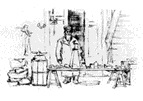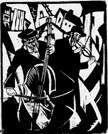
is no plastic music box,
but a David of the shtetl
playing the available harp.
The melody is a midrash of
harmony for ears not attuned to discord.
A Critical Appreciation
"Thirty Years After the World Vanished" is a sensitive selection of the art that defies the Holocaust. Here for rejoicing and renewal are the reflexes of a life, a Chayim, which sustains possessions but is not sustained by them.
[Click either the graphic "thumbnail" or the title. Links from the artist's name lead to more resources about him on the WWW.]
 | Boris Deutsch's Village Fiddler is no plastic music box, but a David of the shtetl playing the available harp. The melody is a midrash of harmony for ears not attuned to discord. |
 | Ilya Schor's Fiddler is to the outside world what Deutsch's is to the inner. It is a public statement. It is a woodcut that creates trees where a bird can sing a dove-song, Peace. |
 | Solomon Yudovin's Maggid is a bit of a popinjay. He is the preacher-poseur-coxcomb who postures and orates while others study and pray. The prayer is an action and his posing is a farce. |
 | Joseph Budko's Kishinev is in the style of Munch. It is violence, the smell of flesh seared - - the lip-tasted ashes. It is warning. It screams. |
 | David Bekkor's Ritual Bath is the cleansing that affirms innocence; it is old wives' tales for the new wife triumphant. It is hoary age growing young at the breast of rebirth. It is time recreating itself. |
 | E. M. Lilien's Double Portrait reminds us that even the wise man needs his sage. The older, more humbled body has a unique stature; its half-closed eyes view eons beyond objects. What the younger man studies the older man has become. |
 | Hermann Struck's Merchant sells dreams with discards. He salvages his livelihood with salvaged goods. Regarded as a discard by the others, he knows his own values as he knows his wares. He is selling dreams to buy herring, which is something to dream about. |
 | David Labcovski's Drayman is an assistant to a horse and an appendage to a wagon. He is Tevyeh waiting for a messianic Sabbath of fish and meat and fowl, as he hungers. He is a life force concealed, his weakness covering his strength. He is survivor all the way, uphill. |
 | Jakob Steinhard's Streetscene is the elongation of a psalmic shadow. It is the pathway which leads only to Jerusalem.| His black-staring window-eyes admit only visions. Realities are Cossacks and SS men. |
 | Todros Geller's Yidl Mitn Fidl is an organizing of disparate spaces into composition. It is impact. It forces a tune out of cacophony. Hear -- the civilizing of violence. |
 | Julius Turner's Day After Day is a parade of prayer being taken home. It is landscape under Divine spell, men being propelled by the Wind of God. |
 | William Gropper's Dance is a ballet of books and ritual fringes. It is a Sinai song composed on a tablet of stone. It has the fiddle, the shofar of the shtetl, accompanied by ecstatic man. The men and books and fringes are flying not because they levitate, but because the world, "the world that has vanished," has sunk beneath them. |
Rabbi William Mordecai Kramer
Professor, California State University at Northridge